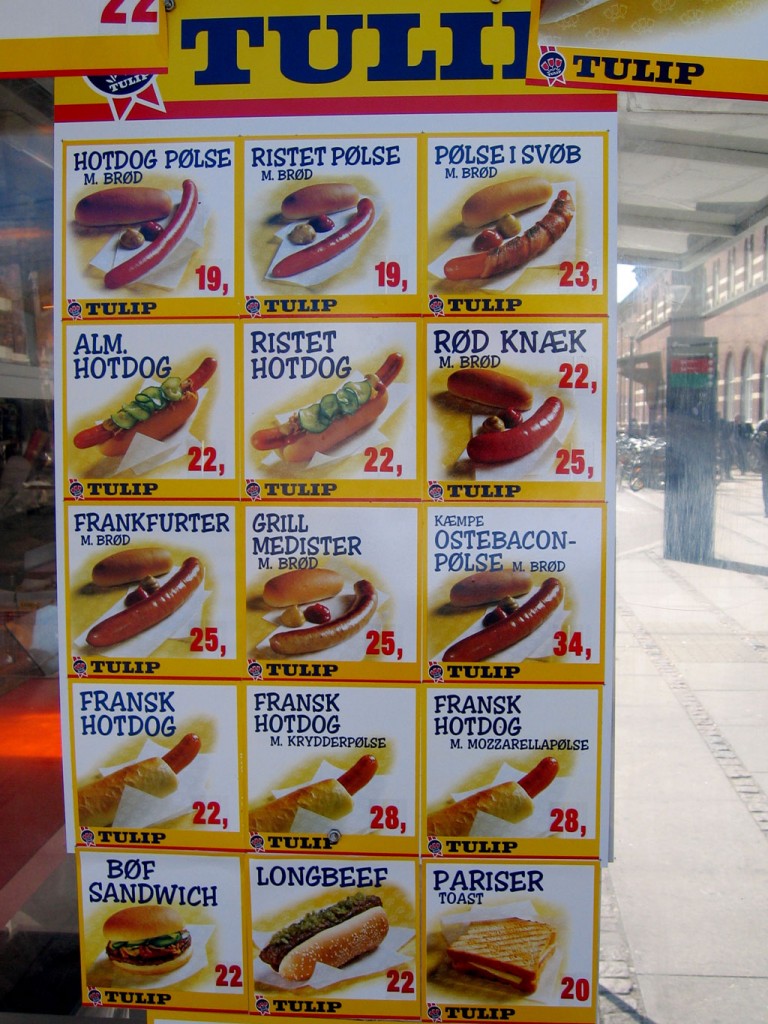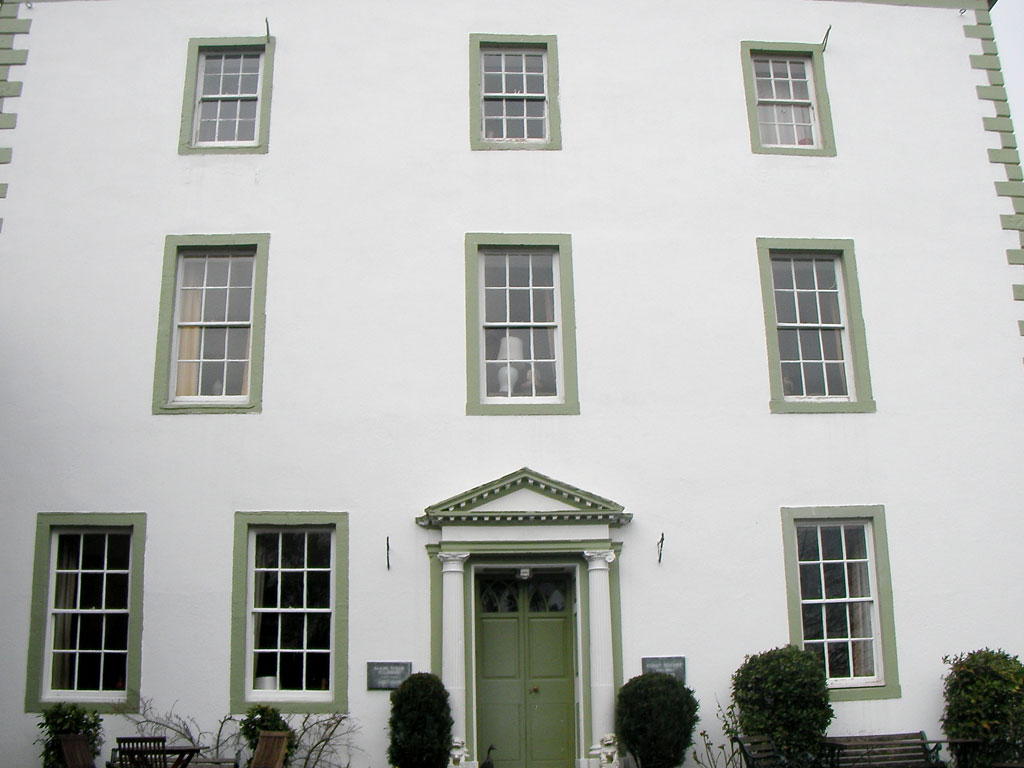* This is the second post in a new weekly series, highlighting stories from the archive for which the is no active link. I’m running them here in full. Subscribe to this blog for more.
They’re long, pink and very, very satisfying. The Danes consumed 27,000 tons of them in the last 12 months alone and companies like Danish Crown and Steff-Houlberg produce over 25 varieties of them, ranging from the humble røde pølse to the exotic-sounding kaempe knaek.
They are, of course, hotdogs, a culinary phenomenon in Denmark and as integral to the Danes’ culinary identity as smorrebrod (open sandwichs) and the koldt bord (cold buffet).
There are hundreds of hotdog stalls (pølsevognen in Danish, meaning “sausage waggon”) in Copenhagen alone, with most privately owned and operating round the clock.
“The food culture in Denmark is very rustic and based on Viking recipes. Hotdogs are the ultimate comfort food for Danes as they need a minimum fat intake to keep warm in the extreme climate,” explains Essex-born chef Paul Cunningham who, in eight years in Copenhagen, has built a reputation as one of the city’s leading chefs.
“The city’s best pølsevognen,” he adds, “are ones that serves the bread warm, and those with home-made sauces and relishes.”
Personally, I’d never been much of hotdog fan. Not until, that is, I tasted my first proper Danish hotdog one Sunday evening in July.
Arriving late, I found myself wandering around Nyhavn, Copenhagen’s picturesque canal-side café district, with a severe case of munchies. With the streets almost deserted and café owners closing up for the night, my eyes were drawn to a lonely fast food stall on Kongens Nytorv, the square that is home to the majestic Charlottenborg Royal Academy of Fine Arts.
Outside a gaudy picture menu displayed a range of unfamiliar sausage and bread roll combos with exotic names like the Ristet Pølse, Pølse I Svob and, rather dubiously, Hot Lips.
The most expensive item on the menu cost 25 Danish kroner (£2) and, presumably the royale with cheese for the hotdog cognoscenti, came served with lashings of ketchup, mustard, fried onions and remoulade, a pickled sauce. I was instantly hooked.
The first hotdog stall was introduced to Copenhagen in 1921 selling hotdogs for 25 “oere” (2.1 cents in today’s money). Today, the Danes take their street food very seriously indeed and prefer one of three types of hotdog: the American, a frankfurter served in a bread roll, the classic pølse med brød, a frankfurter served with bread on the side, and the French dog, which comes served in a half baguette with a customised sausage hole.
All three can be made with any one of 25 different types of sausage. A recent story in the Danish newspaper Politiken reported that 116 million red frankfurters are used each year alone.
Over the next few days I became a man possessed by the quest for the ultimate hotdog. Forget the city’s burgeoning dining scene and celebrated café culture, I wanted it long, thin and served in a bread roll.
Furthermore, I trawled the city’s hotdog stalls, I came to realise that, to the Danes, the hotdog is not just a savoury treat after a night on the local Carlsberg or Tuborg beers, it’s the ultimate social leveller. The pølsevognen is where Danes from all walks of life come to worship en masse at the altar of hotdog haute cuisine.
One night I was happily munching on a Mozzarellapølse outside Q’s club on Axeltorv near the terminally fashionable Latin Quarter. The next day, I found myself sharing an Alm Hotdog and a pleasant chat with a middle-aged businessman at Harry’s Place, a modest stall on Nordre Fasanvej , adjacent to the Norrebro subway station in northwest Copenhagen.
Clearly delighted to share his insider knowledge with a hotdog-hungry foreigner, he told me in conspiratorial tones that Harry’s had, in fact, won the 2001 award for the best hotdog stall in Copenhagen by a local website. With a frisson of excitement, we both hungrily ordered another.
Even the Tivoli Gardens, the family entertainment hub of the city dating from 1843 with its flower gardens, amusement rides and open-air shows, is host to a hotdog stall in keeping with the prevailing ambience — a Art Deco cart dating from the 1920’s. It serves a mean Fransk Dog.
But still I hungered for more. Deep down I knew that somewhere in the city was the holy grail of all hotdogs, a place where man and sausage live in perfect harmony.
On my last day, I found myself following Amagerlandevej, a country road in Kastrup, 10km southeast of the city on the outskirts of Copenhagen’s airport. Acting on a tip-off from the hotdog underground, I was searching for a stall referred to in hushed-tones as ‘Flyvergrillen’, the Flying Grill.
As the road gave way to dirt track, the familiar aroma of fried onions told me I was close.
I jostled through ranks of Danish plane-spotters, fought my way to the front and ordered a pølse med brød, the classic hotdog meal.
My taste buds twitched but then, strangely, a feeling of Zen-like calm washed over my body. This was the greatest hotdog I’d ever tasted — pristinely warmed bread, a meaty red frankfurter and an expert ying and yang balance of tangy remouillade and spicy mustard.
Three days, a dozen hotdogs and a whole slew of disappointments later, my quest was over.
I’d found hotdog heaven.
* This story won the British Guild of Travel Writers European Travel Article of the Year in 2005. It was originally published in the Independent. It was such a good angle, I subsequently sold again it to the Observer.



